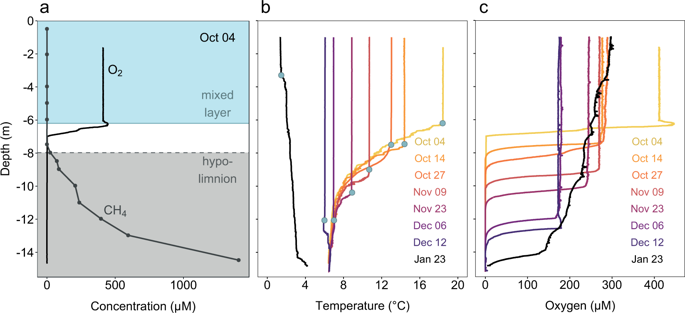当前位置:
X-MOL 学术
›
Commun. Biol.
›
论文详情
Our official English website, www.x-mol.net, welcomes your
feedback! (Note: you will need to create a separate account there.)
Growth and rapid succession of methanotrophs effectively limit methane release during lake overturn.
Communications Biology ( IF 5.2 ) Pub Date : 2020-03-06 , DOI: 10.1038/s42003-020-0838-z Magdalena J Mayr 1, 2 , Matthias Zimmermann 1, 2 , Jason Dey 1 , Andreas Brand 1, 2 , Bernhard Wehrli 1, 2 , Helmut Bürgmann 1
Communications Biology ( IF 5.2 ) Pub Date : 2020-03-06 , DOI: 10.1038/s42003-020-0838-z Magdalena J Mayr 1, 2 , Matthias Zimmermann 1, 2 , Jason Dey 1 , Andreas Brand 1, 2 , Bernhard Wehrli 1, 2 , Helmut Bürgmann 1
Affiliation

|
Lakes and reservoirs contribute substantially to atmospheric concentrations of the potent greenhouse gas methane. Lake sediments produce large amounts of methane, which accumulate in the oxygen-depleted bottom waters of stratified lakes. Climate change and eutrophication may increase the number of lakes with methane storage in the future. Whether stored methane escapes to the atmosphere during annual lake overturn is a matter of controversy and depends critically on the response of the methanotroph assemblage. Here we show, by combining 16S rRNA gene and pmoA mRNA amplicon sequencing, qPCR, CARD-FISH and potential methane-oxidation rate measurements, that the methanotroph assemblage in a mixing lake underwent both a substantial bloom and ecological succession. As a result, methane oxidation kept pace with the methane supplied from methane-rich bottom water and most methane was oxidized. This aspect of freshwater methanotroph ecology represents an effective mechanism limiting methane transfer from lakes to the atmosphere.
中文翻译:

甲烷营养菌的生长和快速演替有效地限制了湖面倾覆过程中甲烷的释放。
湖泊和水库大大增加了大气中强效甲烷的浓度。湖泊沉积物会产生大量甲烷,这些甲烷会积聚在分层湖的缺氧底水中。未来气候变化和富营养化可能会增加具有甲烷存储量的湖泊数量。在每年的湖泊倾覆过程中,储存的甲烷是否逃逸到大气中是一个有争议的问题,并且在很大程度上取决于甲烷营养菌组合的响应。在这里,我们通过结合16S rRNA基因和pmoA mRNA扩增子测序,qPCR,CARD-FISH以及潜在的甲烷氧化速率测量,表明混合湖中的甲烷营养菌组合同时发生了大面积开花和生态演替。结果是,甲烷的氧化与富甲烷底水供应的甲烷保持同步,大多数甲烷被氧化。淡水甲烷营养生态学的这一方面代表了限制甲烷从湖泊向大气转移的有效机制。
更新日期:2020-03-06
中文翻译:

甲烷营养菌的生长和快速演替有效地限制了湖面倾覆过程中甲烷的释放。
湖泊和水库大大增加了大气中强效甲烷的浓度。湖泊沉积物会产生大量甲烷,这些甲烷会积聚在分层湖的缺氧底水中。未来气候变化和富营养化可能会增加具有甲烷存储量的湖泊数量。在每年的湖泊倾覆过程中,储存的甲烷是否逃逸到大气中是一个有争议的问题,并且在很大程度上取决于甲烷营养菌组合的响应。在这里,我们通过结合16S rRNA基因和pmoA mRNA扩增子测序,qPCR,CARD-FISH以及潜在的甲烷氧化速率测量,表明混合湖中的甲烷营养菌组合同时发生了大面积开花和生态演替。结果是,甲烷的氧化与富甲烷底水供应的甲烷保持同步,大多数甲烷被氧化。淡水甲烷营养生态学的这一方面代表了限制甲烷从湖泊向大气转移的有效机制。









































 京公网安备 11010802027423号
京公网安备 11010802027423号